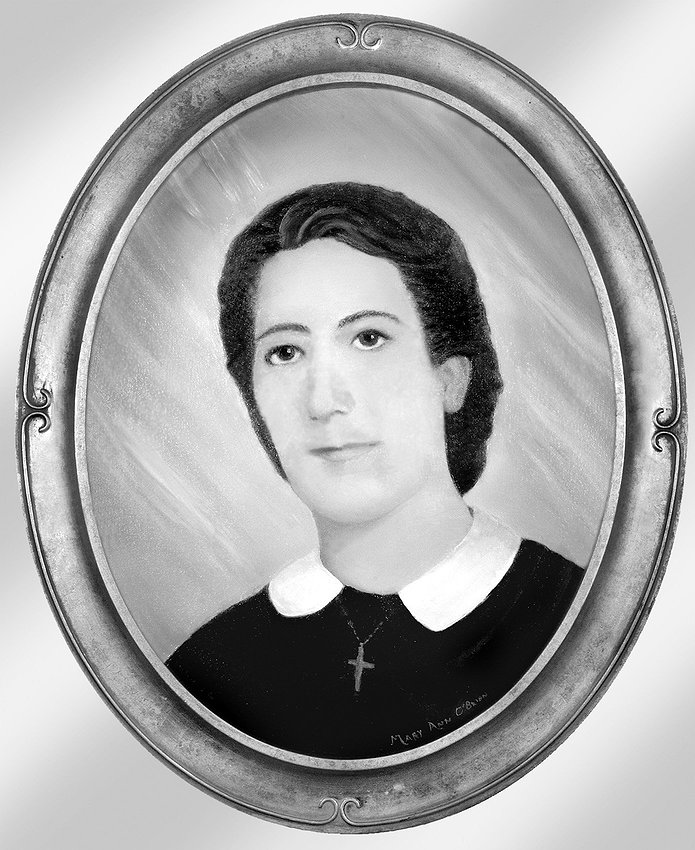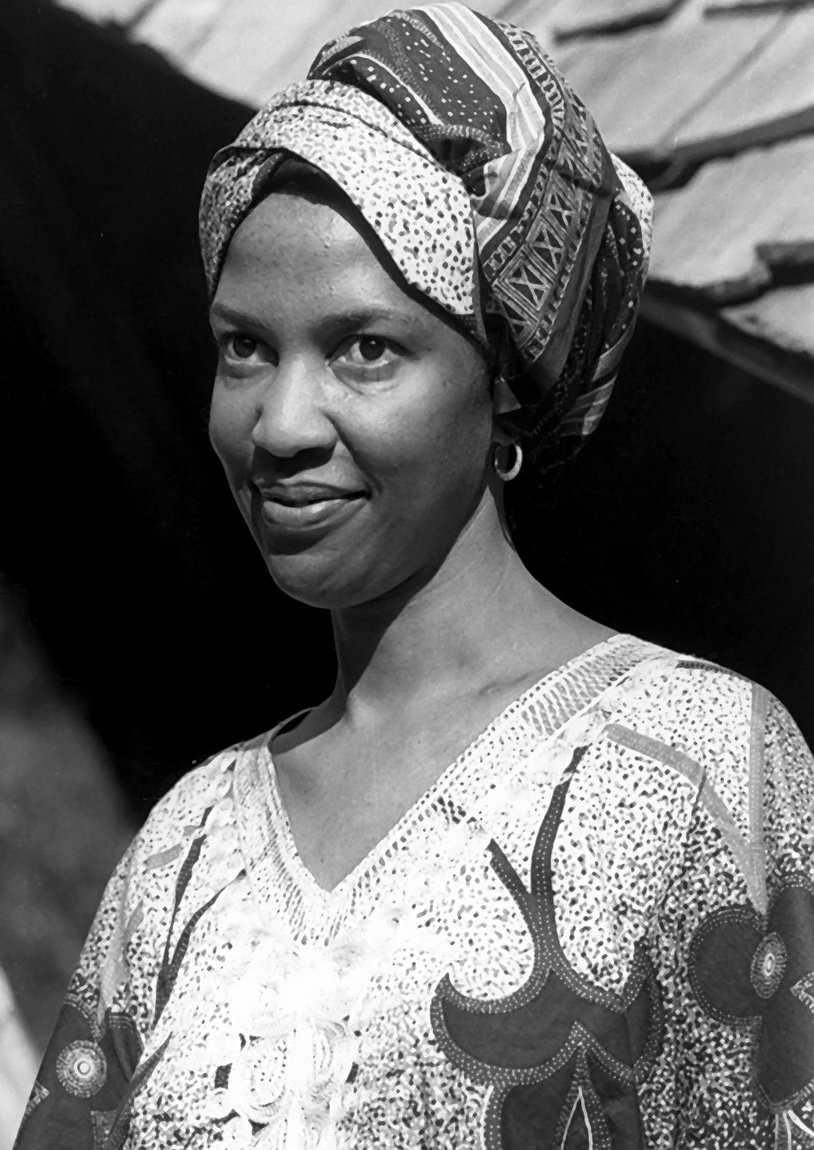Inspirational Black Catholics: A look at six candidates for canonization
November 10, 2024 at 6:51 p.m.

OSV News – We are greatly blessed by the contributions of Black Catholics in the Church in the United States, particularly their illuminating legacy of holiness. The struggles and pain faced by the African American community are succinctly captured in the lives of these six Black Catholics now being considered for canonization. In them we can find the greatest of human characteristics, truly men and women for our times.
– Venerable Pierre Toussaint (1766–1853)
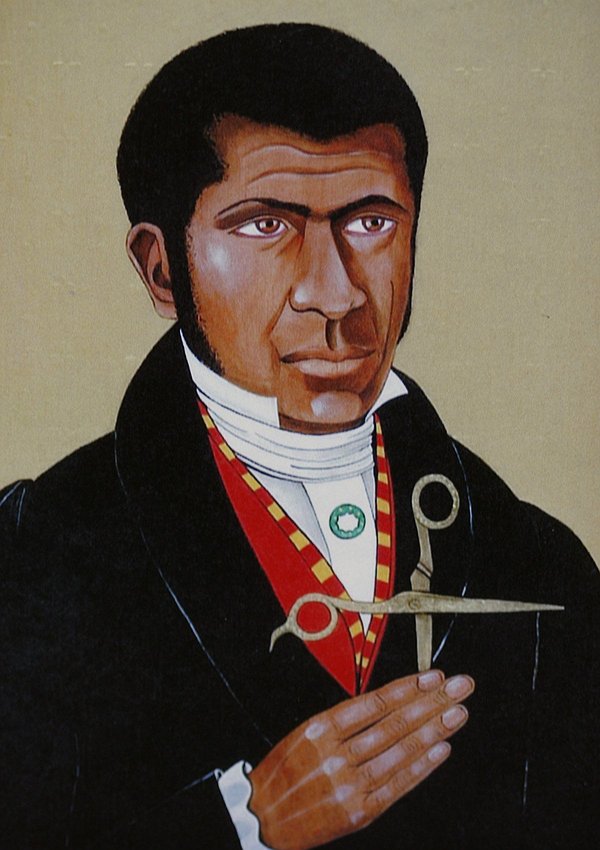 Christina Miller of Baton Rouge, La., painted this image of Pierre Toussaint holding a pair of golden scissors opened in the shape of a cross over his heart. The scissors represent the simple tool that allowed him to make a good living as a hairdresser and in turn do many good works. Toussaint died June 30, 1853, at age 87. (OSV News photo/Bob Roller)
Christina Miller of Baton Rouge, La., painted this image of Pierre Toussaint holding a pair of golden scissors opened in the shape of a cross over his heart. The scissors represent the simple tool that allowed him to make a good living as a hairdresser and in turn do many good works. Toussaint died June 30, 1853, at age 87. (OSV News photo/Bob Roller)Born a slave in Haiti, Toussaint came to New York as property of a French Haitian family, who later freed him in 1807. Establishing himself as a successful hairdresser, Toussaint earned a sizable salary, which he put to use for the good of others, beginning with the purchase of his sister's freedom as well as that of his future wife, Juliette. Together the Toussaints spent their lives in service to the poor and needy. When urged to retire and enjoy his remaining years, Toussaint is quoted as saying, "I have enough for myself, but if I stop working, I have not enough for others."
Toussaint's great charity and works of mercy were fueled by an abiding faith. A daily Mass attendee for more than 60 years, Toussaint lived as he worshiped. Not embittered by the hardships he endured because of his race and his Catholic faith, the model layman gave of himself to others. Toussaint and his wife adopted his niece, took in orphans and funded orphanages, operated a credit bureau, established hostels for priests and refugees, and generously supported the Church and other institutions. Toussaint attended to the sick and suffering, too, even strangers whom he helped nurse to health.
Toussaint died June 30, 1853. In 1990, his remains were moved to a niche in the bishop's crypt at St. Patrick's Cathedral in New York City – a rather poetic postscript to the life of a man whose race once prohibited him from entering the city's Old St. Patrick's Cathedral. He was declared venerable in 1996.
– Venerable Mother Henriette Delille (1812–1862)
Born out of wedlock to a Frenchman and a free woman of color, Henriette Delille spent all her life in and around New Orleans' French Quarter. A cultured young woman of high society, Delille was expected, like her mother and the women of her family, to form a liaison relationship with an eligible white man. After receiving the sacrament of confirmation, however, Delille clearly became a woman committed to the Lord. Her guiding motto, written in a prayer book, captures what defined her heart and spurred her vocation: "I believe in God. I hope in God. I love. I want to live and die for God."
Prevailing racist attitudes, even within the Church, made Delille's pursuit of a religious vocation painful and difficult, and two congregations denied her admittance. Undeterred by the rejection, Delille persevered to establish a religious congregation herself in 1836. Using inheritance from her mother, Delille began what became known as the Sisters of the Holy Family with the aim to serve the poor, sick and elderly, and to teach the faith to both slave and free children.
Delille's generosity and love was known to everyone who knew her. She was a mother to all she encountered, and sacramental records show she even served as godmother and marriage witness to many. She died Nov. 16, 1862, at age 49. An obituary summed up her calling: "For the love of Jesus Christ she had become the humble and devout servant of the slaves." Delille's cause for canonization opened in 1988, and she was declared venerable in 2010.
– Venerable Father Augustus Tolton (1854–1897)
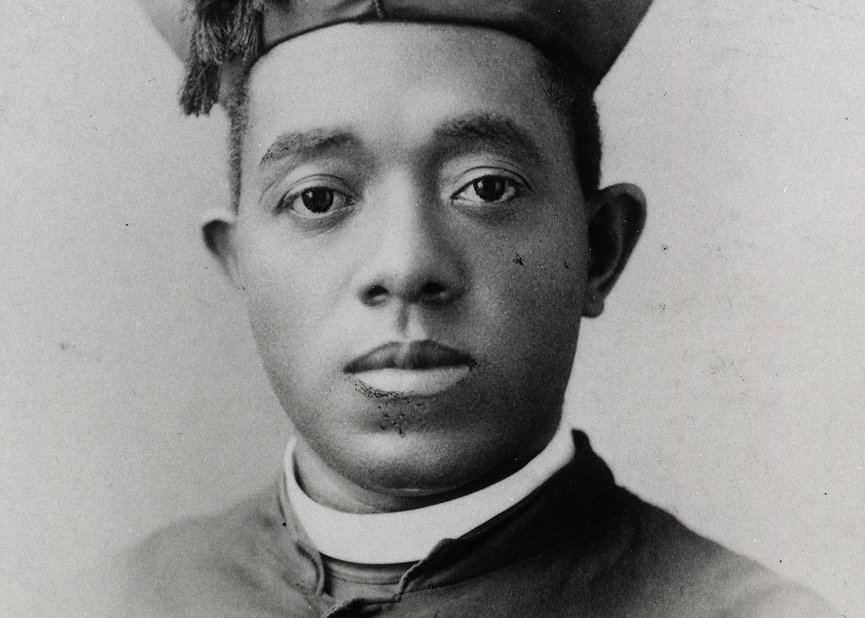 Father Augustus Tolton is pictured in an undated photo. Born into slavery in Missouri, he was ordained a priest April 24, 1886, in Rome and said his first Mass at St. Peter's Basilica. He is the first recognized African American priest ordained for the U.S. Catholic Church and is a candidate for sainthood. (OSV News photo/courtesy of Archdiocese of Chicago Archives and Records Center)
Father Augustus Tolton is pictured in an undated photo. Born into slavery in Missouri, he was ordained a priest April 24, 1886, in Rome and said his first Mass at St. Peter's Basilica. He is the first recognized African American priest ordained for the U.S. Catholic Church and is a candidate for sainthood. (OSV News photo/courtesy of Archdiocese of Chicago Archives and Records Center)Augustus Tolton, born the son of slaves on April 1, 1854, was the first Black individual from the United States to be ordained a priest. But his path to priesthood was not easy.
After a harrowing escape from their Missouri home, Tolton's family settled in freedom in Quincy, Illinois, where the pastor accepted him into the parish school despite much opposition from parishioners. Later, as Tolton began to pursue a priestly vocation, seminaries across the United States rejected his applications out of prejudice.
With heroic determination, Tolton pressed on toward his calling. He was accepted to a seminary in Rome and was ordained there in 1886. Though Tolton expected to serve as a missionary in Africa, he soon found out that he was destined for service back in the United States. "America has been called the most enlightened nation; we will see if it deserves that honor," said Cardinal Giovanni Simeoni, prefect of the Holy See's Congregation for Propagation of the Faith, which oversaw Tolton's seminary. "If America has never seen a black priest, it has to see one now."
Upon his return to Quincy, Father Tolton was met with racial prejudice by laity and clergy alike. An authority even told him not to allow white people to attend his parish. A priest of great humility and obedience, Tolton was invited to minister in Chicago in 1889, and left Quincy thinking he had been a failure there.
In Chicago, Tolton was indefatigable in his efforts to serve a growing Black Catholic community and established St. Monica Church for Black Catholics. Returning from a retreat by train, Tolton collapsed on a Chicago street amid record heat and died July 9, 1897, at the young age of forty-three, and his body was returned to Quincy for burial. Tolton's cause for canonization was opened in 2010, and he was declared venerable in 2019.
– Venerable Mother Mary Lange (c. 1784–1882)
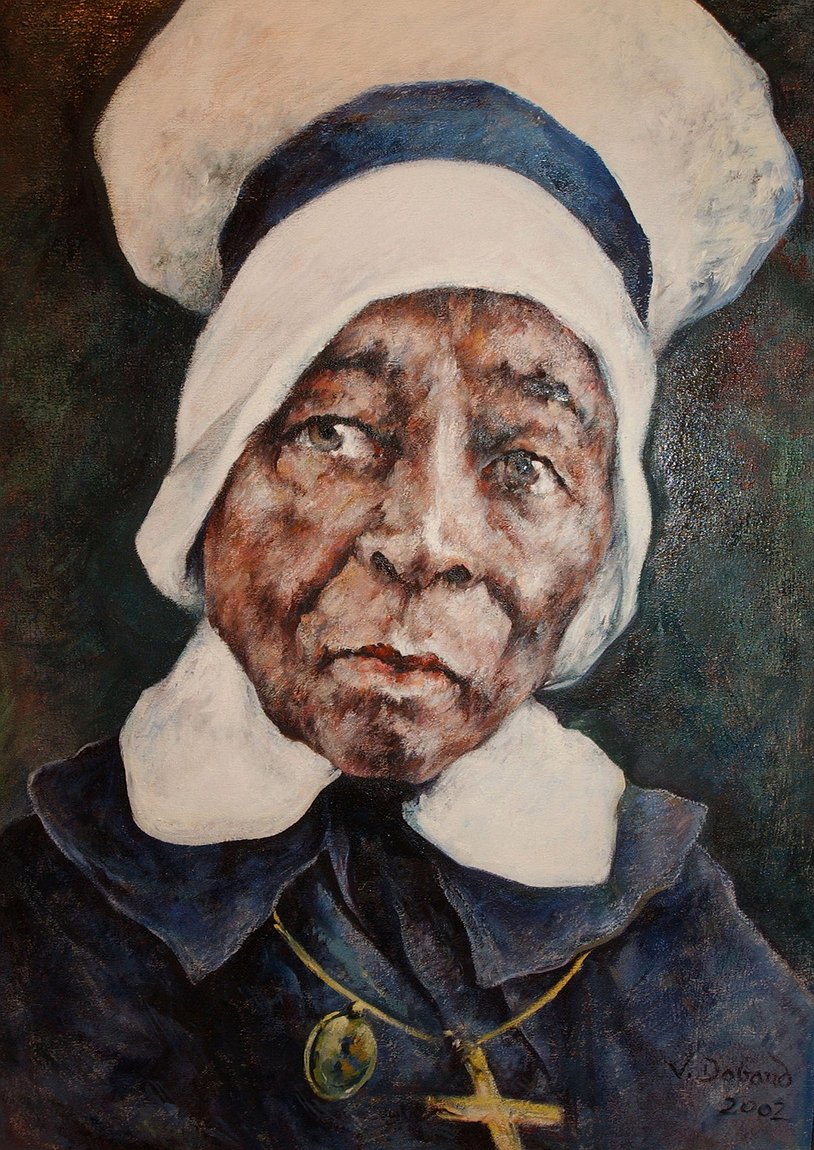 A painting depicts Mother Mary Elizabeth Lange, who founded the Oblate Sisters of Providence in Baltimore, the world's first sustained women's religious community for Black women. Pope Francis signed a decree June 22, 2023, recognizing the heroic virtues of Mother Lange and declaring her "venerable." (OSV News photo/courtesy Catholic Review)
A painting depicts Mother Mary Elizabeth Lange, who founded the Oblate Sisters of Providence in Baltimore, the world's first sustained women's religious community for Black women. Pope Francis signed a decree June 22, 2023, recognizing the heroic virtues of Mother Lange and declaring her "venerable." (OSV News photo/courtesy Catholic Review)Few details are known about the early life of Elizabeth Lange. Likely born in Santiago de Cuba, she emigrated to the United States with a heart ready for service. Known to be of African descent, Lange once described herself as "French to my soul."
God's providence eventually led Lange to Baltimore, where there was a sizable group of French-speaking Catholics who fled Haiti at the time of their revolution. At that time, no free education existed for Black children in Maryland. There, Lange operated a free school out of her home. Financial difficulties eventually forced its closure.
Lange was drawn into further teaching by Sulpician Father James Joubert, who also encouraged her and a few companions to consecrate their lives and work to God as professed religious women. With Mother Mary Elizabeth Lange as the first superior, the Oblate Sisters of Providence were established in 1829 – the first successful congregation for Black women in the United States. With Lange's pioneering vision and holy example, the Oblate sisters persevered through great difficulties and offered their lives in service to all in need – especially to pupils, orphans, widows, the sick and those in spiritual need.
With a humble heart, Lange accepted whatever tasks lay before her. In her final years she patiently endured many hardships. Yet, Lange consistently persevered trusting in God's provident hand. She died Feb. 3, 1882, and her cause for canonization formally was opened in 1991.
– Servant of God Julia Greeley (c. 1840–1918)
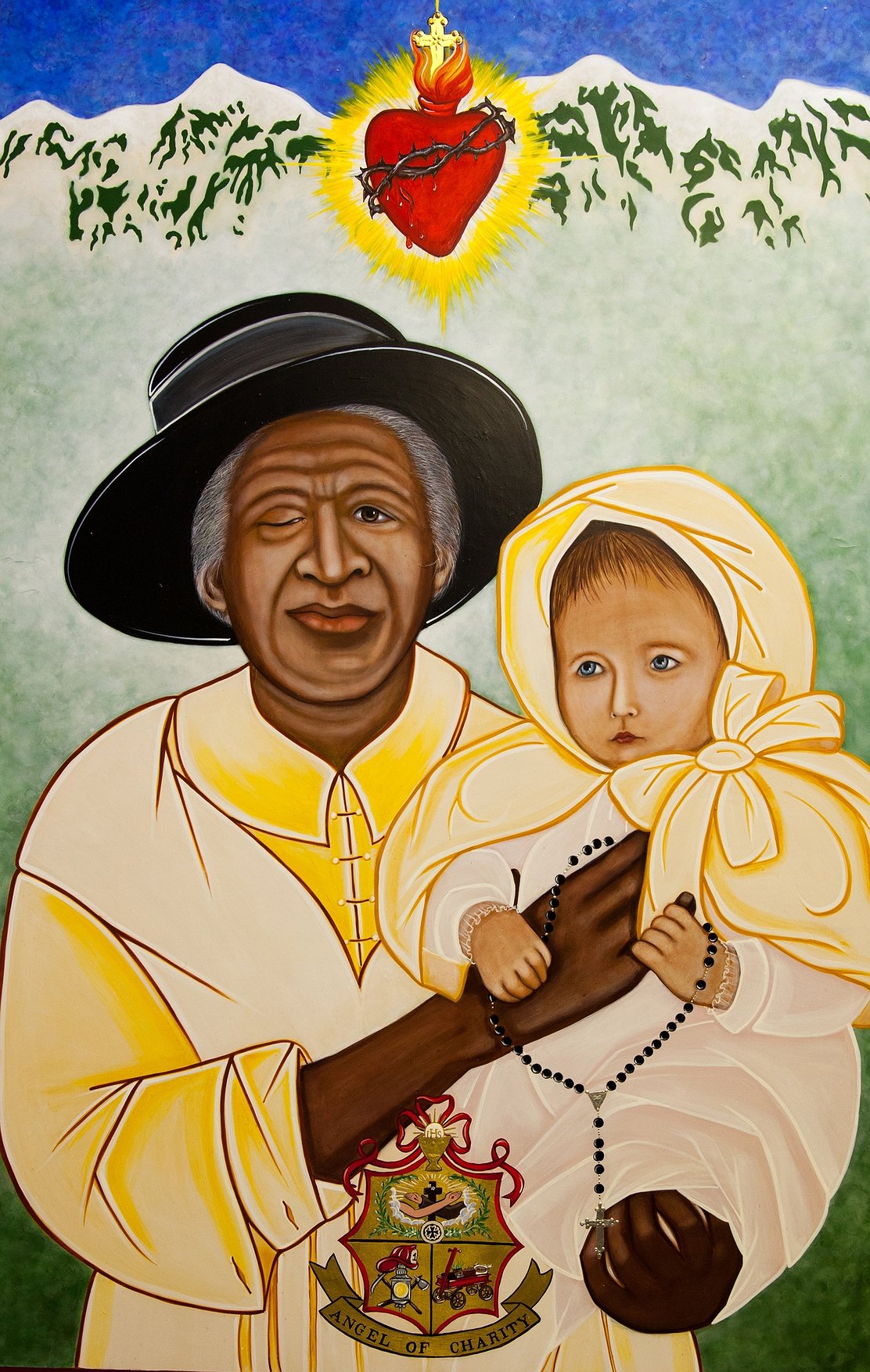 This image of Julia Greeley, a former slave who lived in Colorado, was created by iconographer Vivian Imbruglia, who was commission to do the painting by the Archdiocese of Denver. Greeley's sainthood cause is before the Vatican. (OSV News photo/iconographer Vivian Imbruglia, courtesy Archdiocese of Denver)
This image of Julia Greeley, a former slave who lived in Colorado, was created by iconographer Vivian Imbruglia, who was commission to do the painting by the Archdiocese of Denver. Greeley's sainthood cause is before the Vatican. (OSV News photo/iconographer Vivian Imbruglia, courtesy Archdiocese of Denver)Born into slavery in Hannibal, Missouri, Julia Greeley gained her freedom after the Emancipation Proclamation. Her years as a slave left a permanent mark: a drooping eye, received as the result of a beating. After moving to Colorado in 1879, Greeley fell in love with the Catholic faith. She converted the following year and immediately immersed herself in the devotional and sacramental life of the Church. She attended daily Mass, was devout and pious, and took up intense fasting. When questioned about regularly eating no breakfast, Greeley would respond, "My Communion is my breakfast."
Greeley found great joy in her love for the Sacred Heart of Jesus, which she saw as the source for her many charitable and service-oriented ministries. She was known to spread the devotion, even using it as a tool to evangelize Denver's firemen. From her heart flowed the love of Christ's heart.
Greeley took on a life of poverty, living in union with the poor of Denver. Taking on odd jobs like cooking and cleaning, she used her meager salary to finance a ministry to the poor while suffering from painful arthritis. She could not write, read or count, but wearing her trademark floppy hat Greeley could show Christ's love. She dragged a red wagon filled with goods to distribute to the poor, and, at times, she even begged for them. Many of those she helped were among the nearly 1,000 mourners who attended the funeral after her death on June 7, 1918. Her canonization cause was opened in 2016.
– Servant of God Sister Thea Bowman (1937–1990)
Born in Mississippi on Dec. 29, 1937, Bertha Bowman converted to Catholicism at the age of nine. Missionary priests and sisters began a Catholic school in her hometown to provide a better education for Black children, and it did not discriminate. The Gospel-filled joyfulness of those missionaries attracted the young Bowman to the faith. This same joyfulness became a hallmark trait of hers later on. Bowman was so attracted to their way of life that at fifteen she went on a hunger strike to get her parents' permission to enter as an aspirant with her teachers' order, the Franciscan Sisters of Perpetual Adoration in La Crosse, Wisconsin.
Life in the convent did not protect her from racial prejudice, but she won people over with her joyful, outgoing demeanor and love for Christ and the Church. The daughter of a doctor and a teacher, Sister Thea, her name given upon taking religious vows, was intellectually gifted. She earned a doctorate in English at The Catholic University of America in Washington, D.C., and subsequently served in a variety of teaching roles.
After she, as an only child, returned home to take care of her parents in 1978, Sister Thea served as director for intercultural affairs in the Diocese of Jackson. She dedicated herself to overcoming divisions in the Church and society in the wake of the Second Vatican Council and the racial strife of the 1960s. As a writer, teacher, musician and evangelist, Sister Thea preached the Gospel to clergy and laity alike, promoting ecclesial and cultural harmony and reconciliation as a tireless spokeswoman for the Black Catholic experience. Pledging to "live until I die," Sister Thea remained wholeheartedly committed to her ministry while battling breast cancer for several years. She died March 30, 1990, and her cause for canonization was opened in 2018.
Michael R. Heinlein is editor of "Black Catholics on the Road to Sainthood" and author of "Glorifying Christ: The Life of Cardinal Francis E. George, OMI."
The Church needs quality Catholic journalism now more than ever. Please consider supporting this work by signing up for a SUBSCRIPTION (click HERE) or making a DONATION to The Monitor (click HERE). Thank you for your support.
Related Stories
Monday, December 15, 2025
E-Editions
Events
OSV News – We are greatly blessed by the contributions of Black Catholics in the Church in the United States, particularly their illuminating legacy of holiness. The struggles and pain faced by the African American community are succinctly captured in the lives of these six Black Catholics now being considered for canonization. In them we can find the greatest of human characteristics, truly men and women for our times.
– Venerable Pierre Toussaint (1766–1853)
 Christina Miller of Baton Rouge, La., painted this image of Pierre Toussaint holding a pair of golden scissors opened in the shape of a cross over his heart. The scissors represent the simple tool that allowed him to make a good living as a hairdresser and in turn do many good works. Toussaint died June 30, 1853, at age 87. (OSV News photo/Bob Roller)
Christina Miller of Baton Rouge, La., painted this image of Pierre Toussaint holding a pair of golden scissors opened in the shape of a cross over his heart. The scissors represent the simple tool that allowed him to make a good living as a hairdresser and in turn do many good works. Toussaint died June 30, 1853, at age 87. (OSV News photo/Bob Roller)Born a slave in Haiti, Toussaint came to New York as property of a French Haitian family, who later freed him in 1807. Establishing himself as a successful hairdresser, Toussaint earned a sizable salary, which he put to use for the good of others, beginning with the purchase of his sister's freedom as well as that of his future wife, Juliette. Together the Toussaints spent their lives in service to the poor and needy. When urged to retire and enjoy his remaining years, Toussaint is quoted as saying, "I have enough for myself, but if I stop working, I have not enough for others."
Toussaint's great charity and works of mercy were fueled by an abiding faith. A daily Mass attendee for more than 60 years, Toussaint lived as he worshiped. Not embittered by the hardships he endured because of his race and his Catholic faith, the model layman gave of himself to others. Toussaint and his wife adopted his niece, took in orphans and funded orphanages, operated a credit bureau, established hostels for priests and refugees, and generously supported the Church and other institutions. Toussaint attended to the sick and suffering, too, even strangers whom he helped nurse to health.
Toussaint died June 30, 1853. In 1990, his remains were moved to a niche in the bishop's crypt at St. Patrick's Cathedral in New York City – a rather poetic postscript to the life of a man whose race once prohibited him from entering the city's Old St. Patrick's Cathedral. He was declared venerable in 1996.
– Venerable Mother Henriette Delille (1812–1862)
Born out of wedlock to a Frenchman and a free woman of color, Henriette Delille spent all her life in and around New Orleans' French Quarter. A cultured young woman of high society, Delille was expected, like her mother and the women of her family, to form a liaison relationship with an eligible white man. After receiving the sacrament of confirmation, however, Delille clearly became a woman committed to the Lord. Her guiding motto, written in a prayer book, captures what defined her heart and spurred her vocation: "I believe in God. I hope in God. I love. I want to live and die for God."
Prevailing racist attitudes, even within the Church, made Delille's pursuit of a religious vocation painful and difficult, and two congregations denied her admittance. Undeterred by the rejection, Delille persevered to establish a religious congregation herself in 1836. Using inheritance from her mother, Delille began what became known as the Sisters of the Holy Family with the aim to serve the poor, sick and elderly, and to teach the faith to both slave and free children.
Delille's generosity and love was known to everyone who knew her. She was a mother to all she encountered, and sacramental records show she even served as godmother and marriage witness to many. She died Nov. 16, 1862, at age 49. An obituary summed up her calling: "For the love of Jesus Christ she had become the humble and devout servant of the slaves." Delille's cause for canonization opened in 1988, and she was declared venerable in 2010.
– Venerable Father Augustus Tolton (1854–1897)
 Father Augustus Tolton is pictured in an undated photo. Born into slavery in Missouri, he was ordained a priest April 24, 1886, in Rome and said his first Mass at St. Peter's Basilica. He is the first recognized African American priest ordained for the U.S. Catholic Church and is a candidate for sainthood. (OSV News photo/courtesy of Archdiocese of Chicago Archives and Records Center)
Father Augustus Tolton is pictured in an undated photo. Born into slavery in Missouri, he was ordained a priest April 24, 1886, in Rome and said his first Mass at St. Peter's Basilica. He is the first recognized African American priest ordained for the U.S. Catholic Church and is a candidate for sainthood. (OSV News photo/courtesy of Archdiocese of Chicago Archives and Records Center)Augustus Tolton, born the son of slaves on April 1, 1854, was the first Black individual from the United States to be ordained a priest. But his path to priesthood was not easy.
After a harrowing escape from their Missouri home, Tolton's family settled in freedom in Quincy, Illinois, where the pastor accepted him into the parish school despite much opposition from parishioners. Later, as Tolton began to pursue a priestly vocation, seminaries across the United States rejected his applications out of prejudice.
With heroic determination, Tolton pressed on toward his calling. He was accepted to a seminary in Rome and was ordained there in 1886. Though Tolton expected to serve as a missionary in Africa, he soon found out that he was destined for service back in the United States. "America has been called the most enlightened nation; we will see if it deserves that honor," said Cardinal Giovanni Simeoni, prefect of the Holy See's Congregation for Propagation of the Faith, which oversaw Tolton's seminary. "If America has never seen a black priest, it has to see one now."
Upon his return to Quincy, Father Tolton was met with racial prejudice by laity and clergy alike. An authority even told him not to allow white people to attend his parish. A priest of great humility and obedience, Tolton was invited to minister in Chicago in 1889, and left Quincy thinking he had been a failure there.
In Chicago, Tolton was indefatigable in his efforts to serve a growing Black Catholic community and established St. Monica Church for Black Catholics. Returning from a retreat by train, Tolton collapsed on a Chicago street amid record heat and died July 9, 1897, at the young age of forty-three, and his body was returned to Quincy for burial. Tolton's cause for canonization was opened in 2010, and he was declared venerable in 2019.
– Venerable Mother Mary Lange (c. 1784–1882)
 A painting depicts Mother Mary Elizabeth Lange, who founded the Oblate Sisters of Providence in Baltimore, the world's first sustained women's religious community for Black women. Pope Francis signed a decree June 22, 2023, recognizing the heroic virtues of Mother Lange and declaring her "venerable." (OSV News photo/courtesy Catholic Review)
A painting depicts Mother Mary Elizabeth Lange, who founded the Oblate Sisters of Providence in Baltimore, the world's first sustained women's religious community for Black women. Pope Francis signed a decree June 22, 2023, recognizing the heroic virtues of Mother Lange and declaring her "venerable." (OSV News photo/courtesy Catholic Review)Few details are known about the early life of Elizabeth Lange. Likely born in Santiago de Cuba, she emigrated to the United States with a heart ready for service. Known to be of African descent, Lange once described herself as "French to my soul."
God's providence eventually led Lange to Baltimore, where there was a sizable group of French-speaking Catholics who fled Haiti at the time of their revolution. At that time, no free education existed for Black children in Maryland. There, Lange operated a free school out of her home. Financial difficulties eventually forced its closure.
Lange was drawn into further teaching by Sulpician Father James Joubert, who also encouraged her and a few companions to consecrate their lives and work to God as professed religious women. With Mother Mary Elizabeth Lange as the first superior, the Oblate Sisters of Providence were established in 1829 – the first successful congregation for Black women in the United States. With Lange's pioneering vision and holy example, the Oblate sisters persevered through great difficulties and offered their lives in service to all in need – especially to pupils, orphans, widows, the sick and those in spiritual need.
With a humble heart, Lange accepted whatever tasks lay before her. In her final years she patiently endured many hardships. Yet, Lange consistently persevered trusting in God's provident hand. She died Feb. 3, 1882, and her cause for canonization formally was opened in 1991.
– Servant of God Julia Greeley (c. 1840–1918)
 This image of Julia Greeley, a former slave who lived in Colorado, was created by iconographer Vivian Imbruglia, who was commission to do the painting by the Archdiocese of Denver. Greeley's sainthood cause is before the Vatican. (OSV News photo/iconographer Vivian Imbruglia, courtesy Archdiocese of Denver)
This image of Julia Greeley, a former slave who lived in Colorado, was created by iconographer Vivian Imbruglia, who was commission to do the painting by the Archdiocese of Denver. Greeley's sainthood cause is before the Vatican. (OSV News photo/iconographer Vivian Imbruglia, courtesy Archdiocese of Denver)Born into slavery in Hannibal, Missouri, Julia Greeley gained her freedom after the Emancipation Proclamation. Her years as a slave left a permanent mark: a drooping eye, received as the result of a beating. After moving to Colorado in 1879, Greeley fell in love with the Catholic faith. She converted the following year and immediately immersed herself in the devotional and sacramental life of the Church. She attended daily Mass, was devout and pious, and took up intense fasting. When questioned about regularly eating no breakfast, Greeley would respond, "My Communion is my breakfast."
Greeley found great joy in her love for the Sacred Heart of Jesus, which she saw as the source for her many charitable and service-oriented ministries. She was known to spread the devotion, even using it as a tool to evangelize Denver's firemen. From her heart flowed the love of Christ's heart.
Greeley took on a life of poverty, living in union with the poor of Denver. Taking on odd jobs like cooking and cleaning, she used her meager salary to finance a ministry to the poor while suffering from painful arthritis. She could not write, read or count, but wearing her trademark floppy hat Greeley could show Christ's love. She dragged a red wagon filled with goods to distribute to the poor, and, at times, she even begged for them. Many of those she helped were among the nearly 1,000 mourners who attended the funeral after her death on June 7, 1918. Her canonization cause was opened in 2016.
– Servant of God Sister Thea Bowman (1937–1990)
Born in Mississippi on Dec. 29, 1937, Bertha Bowman converted to Catholicism at the age of nine. Missionary priests and sisters began a Catholic school in her hometown to provide a better education for Black children, and it did not discriminate. The Gospel-filled joyfulness of those missionaries attracted the young Bowman to the faith. This same joyfulness became a hallmark trait of hers later on. Bowman was so attracted to their way of life that at fifteen she went on a hunger strike to get her parents' permission to enter as an aspirant with her teachers' order, the Franciscan Sisters of Perpetual Adoration in La Crosse, Wisconsin.
Life in the convent did not protect her from racial prejudice, but she won people over with her joyful, outgoing demeanor and love for Christ and the Church. The daughter of a doctor and a teacher, Sister Thea, her name given upon taking religious vows, was intellectually gifted. She earned a doctorate in English at The Catholic University of America in Washington, D.C., and subsequently served in a variety of teaching roles.
After she, as an only child, returned home to take care of her parents in 1978, Sister Thea served as director for intercultural affairs in the Diocese of Jackson. She dedicated herself to overcoming divisions in the Church and society in the wake of the Second Vatican Council and the racial strife of the 1960s. As a writer, teacher, musician and evangelist, Sister Thea preached the Gospel to clergy and laity alike, promoting ecclesial and cultural harmony and reconciliation as a tireless spokeswoman for the Black Catholic experience. Pledging to "live until I die," Sister Thea remained wholeheartedly committed to her ministry while battling breast cancer for several years. She died March 30, 1990, and her cause for canonization was opened in 2018.
Michael R. Heinlein is editor of "Black Catholics on the Road to Sainthood" and author of "Glorifying Christ: The Life of Cardinal Francis E. George, OMI."
The Church needs quality Catholic journalism now more than ever. Please consider supporting this work by signing up for a SUBSCRIPTION (click HERE) or making a DONATION to The Monitor (click HERE). Thank you for your support.



